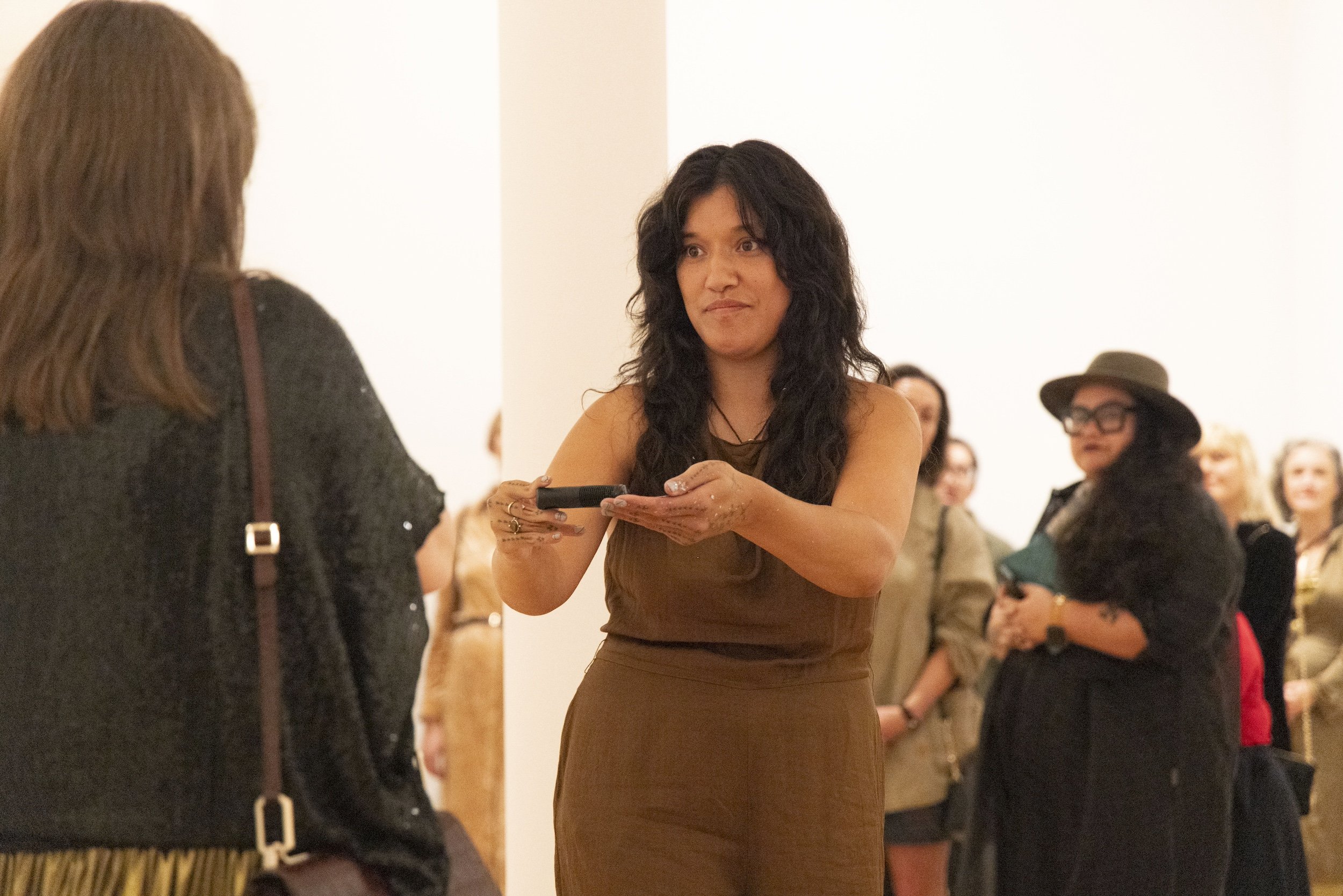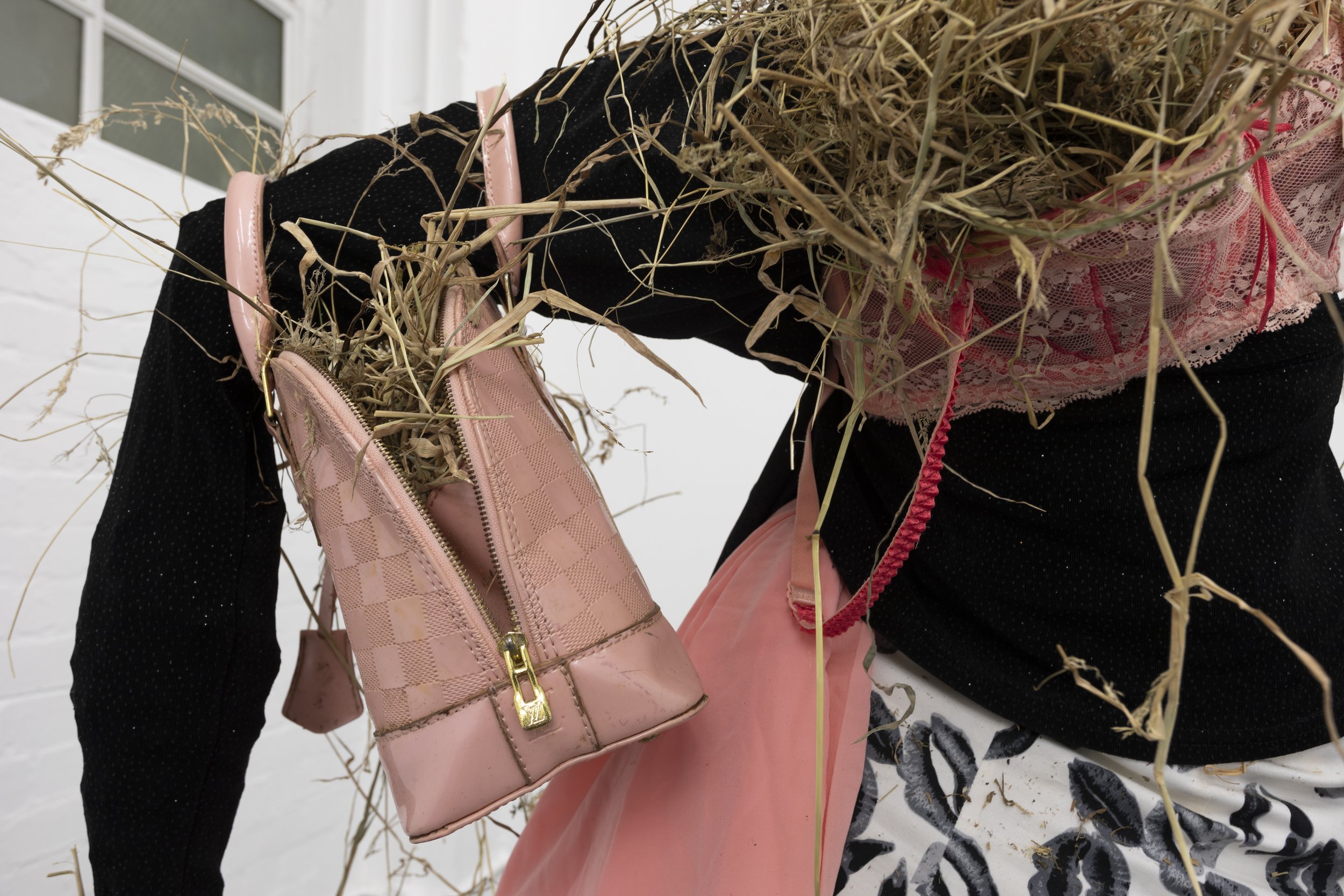Crawling into my mother’s belly
Yeonjae Choi on her current exhibition at Window Gallery, in conversation with curators Hugo Primbs and JingCheng Zhao.
Throughout: Yeonjae Choi with her ceramic jewellery braided in her hair. Photography: Yuyi Hu
Hugo Primbs: I really wanted to start this interview by touching on the title of your exhibition. I noticed that there's quite a lot of emphasis in your work around life and birth and the cyclical nature of the two ideas. However, to me, the title Final Resting Place speaks more to the end of one's life; it doesn't seem to insinuate any sort of continuation. Could you tell us a little bit about the decision for that?
Yeonjae Choi: When I think about life, I think about death simultaneously. Life is cyclical. When I think about what it means to be born and what it means to be alive — the end is always going to be death. And so I think that's why I came up with the idea of a final resting place. But when I think about the title, I envision more emphasis on the ‘resting’ than on the ‘final’.
With these works I was thinking about birth and my life in general. I was thinking about my mum and how when things are hard I want to crawl back into her belly. I want to be reborn and just crawl back into the comforting embrace of my mum. And that's kind of how I see my death; at the end of my life, it'll just be going back to my mum and my childhood days when it was all really easy and restful and nice. I didn't realise it at the time, but when I started putting vaginas on my artwork, it was about this connection of my life to my mum. So that's why it's called Final Resting Place. I feel really embarrassed writing about this part of my work, so in all of my artist statements I never really talk about how much my mum — and how much thinking about my mum — influences my artwork. But when I talk about it, it comes out.
JingCheng Zhao: You described the action of crawling back into the belly. There's a similarity to how you invite audiences to engage — to peer inside the bodies of these ceramic figures.
YC: Yeah, I love watching people look at my work. There’s this sort of initial, ‘Oh, is that a vagina?’; but then, ultimately, I hope everybody has the same calming experience that I have when I look inside my works. The imagery that I put inside is of places that I'm familiar with. I think that sort of imagery — of just one person surrounded by vast nature — I think that brings the same calm feeling to everybody.
HP: Continuing that same train of thought, I know that this body of work was shown at Depot Artspace at the end of last year under the same title. I understand there are a few pieces that were in that exhibition at Depot that aren't included in this iteration, but I'm interested, how do you think the reading of your work differs between the two spaces?
YC: My works are very touchable — people want to get closer. And maybe that is part of the performance, that the audience are invited to interact. But the reading does change a little bit at Window, in the sense that there's more of a distance between the viewer and the work. When I was installing, I did think it was quite a shame that there was the barrier with the window, but it can't be helped. When looking at the imagery inside each figure though, I think it has the same impact.
HP: Speaking of the video, this was produced in collaboration with Anasa Fraser. You mentioned in your exhibition text that she appeared in your life like an angel, and that you share “roller skating Sundays" together. Could you talk about your relationship with her and how collaborating influenced the work?
YC: Anasa signed up to one of the pottery classes that I sometimes run for adults, and we just hit it off. During the class we discovered that we both roller skate and we live quite near each other. So every Sunday we go to the park and roller skate.
She was asking me about my work and about my upcoming projects and I mentioned that I wanted to put videos in my next exhibition. To which she replied, “Oh, I'm a videographer!” So I was like, “Perfect! Let's work together.”
This particular collaboration was so easy for me; we were so comfortable with each other and Anasa saw my vision so clearly. What she produced for me was exactly what I wanted. I think that's all I really have to say about it. It was just this perfect moment in life where her creative practice and mine met at the right time — and it worked!
JZ: My first impression of the bodies is that they look extremely comfortable, lying on the cushions. I saw your show Fluid Borders: Far Nearer at the Pah Homestead in 2020 and, seeing your work now, I realised that the texture and the colour of your work at Window is quite different to previous works. I wonder, is that related to what you are trying to discuss? These works are warm and quite soft, compared to the ones I’d seen before.
YC: So, this series is unglazed. They're still ceramic, but they're unglazed and the colours are from pastel. Glazing is not a very joyful process for me. It's really stressful and I hate doing it — nothing ever comes out the way that I want it to. I really wanted these works to look soft and the colours to look like they are just powdered on. I was thinking, How can I achieve that with glazes?
When I made the first figure it cracked in the kiln while it was bisque firing. But I think that’s what saved me, because if it hadn't cracked, I think I would have just glazed it. But because it cracked, I thought, Oh no, if I put it in the kiln again, it's going to become a disaster; the cracks are just going to become bigger and bigger. So I decided not to glaze them and just fill the cracks and paint the whole thing with a texture paste.
Then one day I was in Gordon Harris and I saw this new product called PanPastels. I love them, they’re a soft pastel that comes in little tins like makeup blush powder. I thought they were so perfect. I just applied it with a sponge – like I would makeup — and it worked so beautifully. I was very happy with the result.
In the Depot exhibition, there was also a really, really big mother sculpture made out of chicken wire and plaster. You can't glaze plaster, so I’m glad that the finishing method that I chose for the ceramic works ended up tying in with this other work very nicely.
HP: You’re moving to Australia later this year. In your exhibition text you address how you’ve had to endure two unwanted migrations as a child, feeling “ripped away from home by your parents.” How is this move different now that it’s — I'm guessing — a voluntary decision?
YC: It’s semi voluntary (laughs). I think I'm going to feel better about it this time. I'm moving, coincidentally, back to my mum's house. I'm happy and dreading it at the same time. If I'm telling the truth, I'm moving because I'm too poor to stay in New Zealand and continue living.
HP: It’s a relatable thing! How do you think this move might influence your work?
YC: I’m hoping that I'm going to move away from ceramics a little bit, and more into the plaster sculptures. I’ve found that with ceramics I need so much outward help with firing my work. I always need to go somewhere else to do it. Just to make my life a little bit easier, I’m trying to move into an area of making where I can do it all at home, in my own studio. Having said that out loud, it sounds really introverted of me, but that is who I am.












